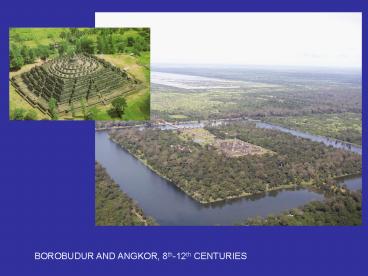BOROBUDUR AND ANGKOR, 8th12th CENTURIES - PowerPoint PPT Presentation
1 / 39
Title: BOROBUDUR AND ANGKOR, 8th12th CENTURIES
1
BOROBUDUR AND ANGKOR, 8th-12th CENTURIES
2
Two cultural foci in South-East Asia Java and
Khmer
Impact of Indian culture on South-East Asia, and
the production of monumental architecture through
a syncretic treatment of Buddhism and Hinduism
3
The architectural impacts gtMandala and the
cosmological system gtMeru, world-mountain gtMythic
geography of India gtTemple tower as
mountain gtSiva as revered deity
4
Buddhist architectural Organization Mandala Sacr
ed precinct Center and periphery Center as most
sacred Protected periphery Gateways Vertical axis
5
Significance of Hindu temple gtdwelling of
god gtbody of god gtchariot of god gtworld
mountain gtmanifestation of mandala
6
Spire gtmultiplication of form gtstratification
7
BARABUDUR, JAVA (INDONESIA), 8th-9th CENTURY
CE gtDictated by Buddhist religious principles
rather than architectural gtFinest translation of
a religious idea the Stupa and the
Mandala gtSymbolizes the world-mountain
Meru gtThe sequential ascension from mundaneness
to enlightenment
8
(No Transcript)
9
(No Transcript)
10
(No Transcript)
11
(No Transcript)
12
(No Transcript)
13
Nine terraces or stages that lead to
nirvana gtEach terrace with an ambulatory gtAmbulat
ory displays Jataka art gt5 rectangular, closed
terraces gt3 circular, open terraces gtThe crowning
central stupa Jatakas narratives on the past
lives of the Buddha.
14
gtRectangular terrace with ambulatory gtJataka
art on display
15
Circular terraces with perforated stupas and
Buddha figures
16
ANGKOR WAT, CAMBODIA, 857-1300 gtKhmer Culture,
Classical period 12th-13th c. gtRelation between
Java and Khmer gtJayavarman II arrives from
Java gtThe cult of god-king, highly centralized
authority Buddhist-Hindu syncretism
17
(No Transcript)
18
(No Transcript)
19
(No Transcript)
20
gtAngkor Wat as cosmological model, a
mandala gtAgricultural and religious landscape
organized gtWater as important organizing
element gtUrban irrigation system as economic
base gtTemple as sacred mountain ringed by
ocean gtSeven concentric rings around the
mountain
21
(No Transcript)
22
- \
Buddhist and Hindu syncretism
23
gtCosmological model gtCardinal points represent
astrological values gtQuinclux plan central
tower with four corner towers gtCentral tower as
sanctuary gtSanctuary is a dark, undecorated
interior gtLater stuctures towers with galleries
and tiered platforms gtLandscaping
24
(No Transcript)
25
gtNaga, serpent and water being gtMoat and cosmic
ocean gtCauseway, bridge between man and gods
26
(No Transcript)
27
gtLandshaping gtLandscaping gtSymbolic forms gtFormal
planning gtExuberant sculptures
28
(No Transcript)
29
(No Transcript)
30
(No Transcript)
31
(No Transcript)
32
(No Transcript)
33
BAYON ANGKOR THOM 1180-1218
34
(No Transcript)
35
(No Transcript)
36
Buddha head as motif anthropomorphic Identified
with king Jayavarman
37
(No Transcript)
38
(No Transcript)
39
(No Transcript)































